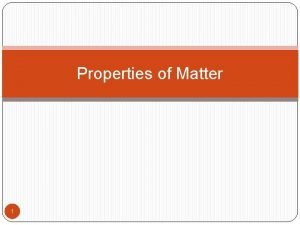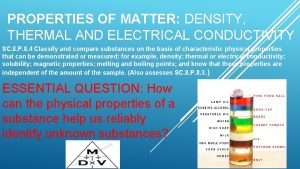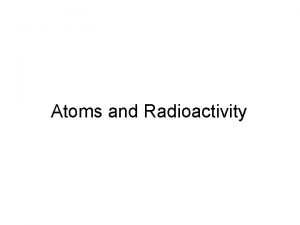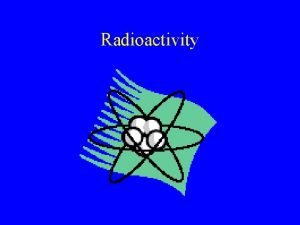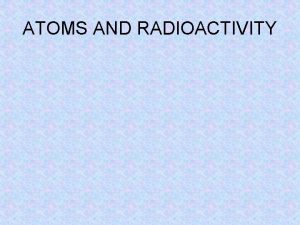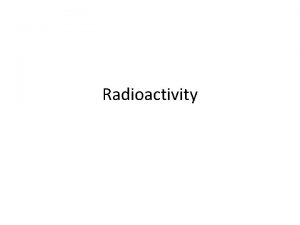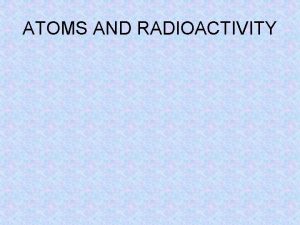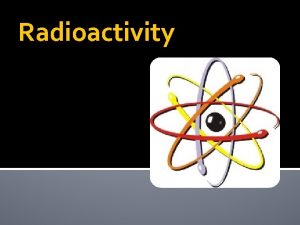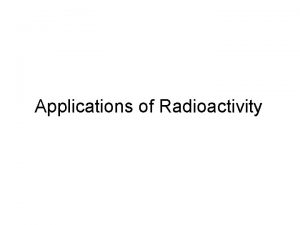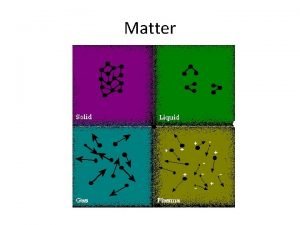Structure of matter Radioactivity Radioactivity is a property













- Slides: 13

Structure of matter Radioactivity

Radioactivity is a property, exhibited by certain types of matter, of emitting energy and subatomic particles spontaneously. It is an attribute of individual atomic nuclei; is a natural phenomenon, present everywhere: in stars, in the Earth and in living organism.

Structure of the atom The nucleus of the atom is composed of protons (positive electric charge +) and neutrons (zero charge). The atom is electrically neutral: the nucleus is surrounded by electrons (negative electric charge -), equal in number to the protons present in the nucleus.

Structure of the atom The structure of the atom is the same for all the chemical elements. What changes from one element to another one is the number of protons and neutrons. The total number of protons in the nucleus is called "atomic number" and is indicated by the letter Z. The chemical element with 8 protons is oxygen (O), that with 26 protons is iron, that with 79 protons is gold and so on. . .

Isotopes In a nucleus of an element there may be N neutrons, the sum A = N + Z is called mass number. The nuclei with the same value of Z (protons) but different values of A (that is, with a different number of neutrons) are called isotopes.

Radioactive isotopes The isotopes present in nature almost all stable. However, some natural isotopes, and almost all artificial isotopes, are unstable due to an excess of protons and / or neutrons. Such instability causes their spontaneous transformation into other isotopes accompanied by particle emission (radiation). These isotopes are called radioactive isotopes.

Radioactive decay The transformation of a radioactive isotope produce another isotope, which can be radioactive or stable. This transformation is called radioactive decay. Is not possible to determine the exact instant in which single isotopes will decay. The radioactive decay, in each isotopes, respect a well know statistic frequency.

Half Life Half-life is the interval of time required for one-half of the atomic nuclei of a radioactive sample to decay (change spontaneously into other nuclear species by emitting particles and energy), or, equivalently, the time interval required for the number of disintegrations per second of a radioactive material to decrease by one-half.

Radiation and Shield There are three different types of radioactive decay, which differ from the type of particle emitted following decay. The emitted particles are indicated by generic name of radiation. • Alfa • Beta • Gamma

Alfa Decay Following an alpha decay, the nucleus (Z, A) emits a particle alfa ( a helium nucleus = 2 protons + 2 neutrons) and converts to a different nucleus with atomic number (Z - 2) and mass number (A-4).

Beta Decay The nucleus emits an electrons and an anti-neutron and becomes a nucleus with charge (Z + 1), but same mass number A.

Gamma decay The nucleus does not transform but passes into a lower state of energy and emits a photon; gamma radiation often accompanies that a or b.

Gieger Counter The activity of a radioactive source is defined as the number of decays in the unit of time. It is measured in Bequerel (Bq) which is equivalent to a decay per second. The instrument to measure the radioactive activity is the Geiger counter.
 Commutative and associative properties
Commutative and associative properties Doctrine of blending
Doctrine of blending Physical and chemical properties
Physical and chemical properties Common properties of matter
Common properties of matter General property of matter
General property of matter Electrical conductivity property of matter
Electrical conductivity property of matter What property of matter that describes a rusty anchor.
What property of matter that describes a rusty anchor. F=kx
F=kx Strength property of matter
Strength property of matter Hardness property of matter
Hardness property of matter Section 1 composition of matter
Section 1 composition of matter Grey matter
Grey matter Composition of matter section 1
Composition of matter section 1 Chapter 2 section 1 classifying matter answers
Chapter 2 section 1 classifying matter answers



